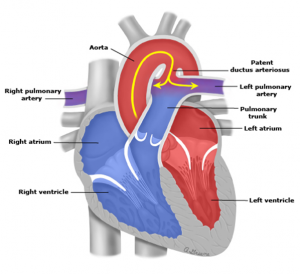
In the fetus, the ductus arteriosus links the pulmonary artery with the aorta. At this time, the pressure in the pulmonary circulation is greater than in the systemic circulation to that blood flows from right to left i.e. from the pulmonary artery into the aorta.
After birth, the ductus close in response to the raised pO2 in the blood and the fibroses up and becomes the ligamentum arteriosus. The ductus may, however, fail to close and this is termed patent ductus arteriosus. This is the 3rd commonest forms of congenital heart disease after ventricular septal defects and atrial septal defects. Like these conditions, it is associated with a left to right shunt (because of the relatively high pressures in the systemic circulation). The magnitude of the shunt will depend on the diameter of the ductus. With time, as a result of the increased blood flow to the lungs, pulmonary hypertension may develop and if the pressure becomes great enough the shunt will reverse becoming right to left (as in the fetus).
This failure to close is common in premature infants when the ductus will usually, in the end, close spontaneously, in the end. Patent ducts arteriosus is commoner in babies with, e.g., Down’s syndrome and congenital rubella. In term infants, it rarely closes on its own. Treatment may be by instilling prostaglandin inhibitors, which cause contraction, or by surgery. Infective endocarditis may develop in untreated cases.